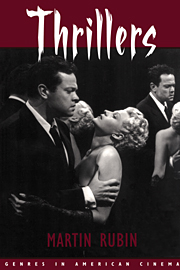Book contents
- Frontmatter
- Contents
- List of Illustrations
- Acknowledgments
- PART I APPROACHES
- PART II HISTORICAL OVERVIEW
- PART III FILM ANALYSES
- 6 The Detective Thriller: The Kennel Murder Case (1933), The Big Sleep (1946)
- 7 The Psychological Crime Thriller: Strangers on a Train (1951)
- 8 The Spy Thriller: Man Hunt (1941)
- 9 The Police Thriller: The French Connection (1971)
- 10 Conclusion
- Notes
- Selected Bibliography
- Filmography/Videography
- Index
6 - The Detective Thriller: The Kennel Murder Case (1933), The Big Sleep (1946)
Published online by Cambridge University Press: 04 December 2009
- Frontmatter
- Contents
- List of Illustrations
- Acknowledgments
- PART I APPROACHES
- PART II HISTORICAL OVERVIEW
- PART III FILM ANALYSES
- 6 The Detective Thriller: The Kennel Murder Case (1933), The Big Sleep (1946)
- 7 The Psychological Crime Thriller: Strangers on a Train (1951)
- 8 The Spy Thriller: Man Hunt (1941)
- 9 The Police Thriller: The French Connection (1971)
- 10 Conclusion
- Notes
- Selected Bibliography
- Filmography/Videography
- Index
Summary
As noted in Chapter 1, the thriller is an imprecise concept, widely applied and difficult to pin down. On the one hand, it spreads itself over several acknowledged genres, such as spy, detective, police, and horror. On the other hand, within an individual genre some works may be considered thrillers and others not. In order to approach this problem, therefore, it might be useful to seek a borderline in one of those genres that contain both thrillers and nonthrillers.
Such an opportunity is provided by the detective story, one of the earliest and most durable of thriller-related genres. The detective genre has been subdivided into two primary categories by several critics and authors, including acclaimed novelist Raymond Chandler. In his often quoted 1944 article “The Simple Art of Murder,” Chandler draws a strongly biased distinction between the “formal detective story,” practiced by such authors as Agatha Christie and Dorothy L. Sayers, and the “realistic style,” pioneered by Dashiell Hammett (and carried on by Chandler himself). More recently, the same basic division has been examined by John G. Cawelti, whose 1976 book Adventure, Mystery, and Romance is discussed in Chapter 2, and Tzvetan Todorov, an important French theorist-critic whose extensive writings on literature, language, and genre include the concise 1966 essay “The Typology of Detective Fiction.” Todorov labels the first type of detective story the whodunit; Cawelti uses the term classical detective story to refer to the same thing.
- Type
- Chapter
- Information
- Thrillers , pp. 181 - 202Publisher: Cambridge University PressPrint publication year: 1999



